Shortcodes included with WooCommerce
ABOUT
The Coupon Shortcodes extension allows you to render coupon information and show content based on the validity of coupons.
Customers can be motivated to proceed with their purchase, offering them to use specific coupons when the contents in the cart qualify for it, or by offering them to purchase additional items so they can use a coupon.
Conditional Shortcodes
It provides the following conditional shortcodes that allow enclosing content which is shown if coupons are applied, valid or not valid.
[coupon_is_active][coupon_is_not_active][coupon_is_applied][coupon_is_not_applied][coupon_is_valid][coupon_is_not_valid]
Coupon Info Shortcodes
It also provides shortcodes that allow to render the coupon code, its description and an automatic description of the discount:
[coupon_code]– renders a coupon code[coupon_description]– renders a coupon’s description[coupon_discount]– renders information about the discount of a coupon[coupon_show]– renders coupon code, discount info and description together
A coupon enumerator shortcode allows to list all or a set of coupons, to show their code, description or discount information:
[coupon_enumerate]
Documentation
Please refer to the plugin’s documentation for detailed descriptions.
Examples
Show a text when a coupon can be used (active) – this is useful to show promotional info while coupons can be used, as active means that the coupon has not reached its expiration date nor exceeded its usage limits:
[coupon_is_active code="eastereggs"] Happy Easter! Use the coupon code [coupon_code] to hop away with a great discount : [coupon_discount] [/coupon_is_active]
This is an example of a text shown when a promotion is over:
[coupon_is_not_active code="specialdiscount"] Our special discount sale has ended. Come back often to see more! [/coupon_is_not_active]
Showing a coupon when the cart contents qualify for a coupon to be applied:
[coupon_is_valid code="superdiscount"] You qualify for a discount! Use the coupon code [coupon_code] to take advantage of this great discount : [coupon_discount] [/coupon_is_valid]
Showing a coupon that is not valid for the current cart and motivating to add items:
[coupon_is_not_valid code="25off"] If you purchase 5 Widgets, you can use the coupon [coupon_code] to get 25% off your purchase! [/coupon_is_not_valid]
Show information about three random coupons, including the coupon code, its description and discount info together on each entry:
[coupon_enumerate code="*" orderby="rand" number="3"] [coupon_show show="code,description,discount"] [/coupon_enumerate]
Show a single random coupon code:
[coupon_enumerate code="*" orderby="rand" number="1"] [coupon_code] [/coupon_enumerate]
SETUP

How to use shortcodes
Where to use

Args (or Arguments)
Page Shortcodes

[woocommerce_cart] – shows the cart page[woocommerce_checkout] – shows the checkout page[woocommerce_my_account] – shows the user account page[woocommerce_order_tracking] – shows the order tracking formCart
Checkout
[woocommerce_cart]
My Account
array( 'current_user' => '' )
[woocommerce_my_account]Current user argument is automatically set using get_user_by( 'id', get_current_user_id() ).

Order Tracking Form
[woocommerce_order_tracking]
Products

The [products] shortcode is one of our most robust shortcodes, which can replace various other strings used in earlier versions of WooCommerce.
The [products] shortcode allows you to display products by post ID, SKU, categories, attributes, with support for pagination, random sorting, and product tags, replacing the need for multiples shortcodes such as [featured_products], [sale_products], [best_selling_products], [recent_products], [product_attribute], and [top_rated_products], which are needed in versions of WooCommerce below 3.2. Review the examples below.
Available Product Attributes
- limit – The number of products to display. Defaults to and -1 (display all) when listing products, and -1 (display all) for categories.
- columns – The number of columns to display. Defaults to 4.
- paginate – Toggles pagination on. Use in conjunction with limit. Defaults to false set to true to paginate .
- orderby – Sorts the products displayed by the entered option. One or more options can be passed by adding both slugs with a space between them. Available options are:
- date – The date the product was published.
- id – The post ID of the product.
- menu_order – The Menu Order, if set (lower numbers display first).
- popularity – The number of purchases.
- rand – Randomly order the products on page load (may not work with sites that use caching, as it could save a specific order).
- rating – The average product rating.
- title – The product title. This is the default orderby mode.
- skus – Comma-separated list of product SKUs.
- category – Comma-separated list of category slugs.
- tag – Comma-separated list of tag slugs.
- order – States whether the product order is ascending (ASC) or descending (DESC), using the method set in orderby. Defaults to ASC.
- class – Adds an HTML wrapper class so you can modify the specific output with custom CSS.
- on_sale – Retrieve on sale products. Not to be used in conjunction with best_sellingor top_rated.
- best_selling – Retrieve the best selling products. Not to be used in conjunction with on_sale or top_rated.
- top_rated – Retrieve top-rated products. Not to be used in conjunction with on_saleor best_selling.
- attribute – Retrieves products using the specified attribute slug.
- terms – Comma-separated list of attribute terms to be used with attribution.
- terms_operator – Operator to compare attribute terms. Available options are:
- AND – Will display products from all of the chosen attributes.
- IN – Will display products with the chosen attribute. This is the default terms_operator value.
- NOT IN – Will display products that are not in the chosen attributes.
- tag_operator – Operator to compare tags. Available options are:
- AND – Will display products from all of the chosen tags.
- IN – Will display products with the chosen tags. This is the default tag_operator value.
- NOT IN – Will display products that are not in the chosen tags.
- visibility – Will display products based on the selected visibility. Available options are:
- visible – Products visible on shop and search results. This is the default visibility option.
- catalog – Products visible on the shop only, but not search results.
- search – Products visible in search results only, but not on the shop.
- hidden – Products that are hidden from both shop and search, accessible only by direct URL.
- featured – Products that are marked as Featured Products.
- category – Retrieves products using the specified category slug.
- tag – Retrieves products using the specified tag slug.
- cat_operator – Operator to compare category terms. Available options are:
- AND – Will display products that belong in all of the chosen categories.
- IN – Will display products within the chosen category. This is the default cat_operator value.
- NOT IN – Will display products that are not in the chosen category.
- ids – Will display products based on a comma-separated list of Post IDs.
- SKUs – Will display products based on a comma-separated list of SKUs.

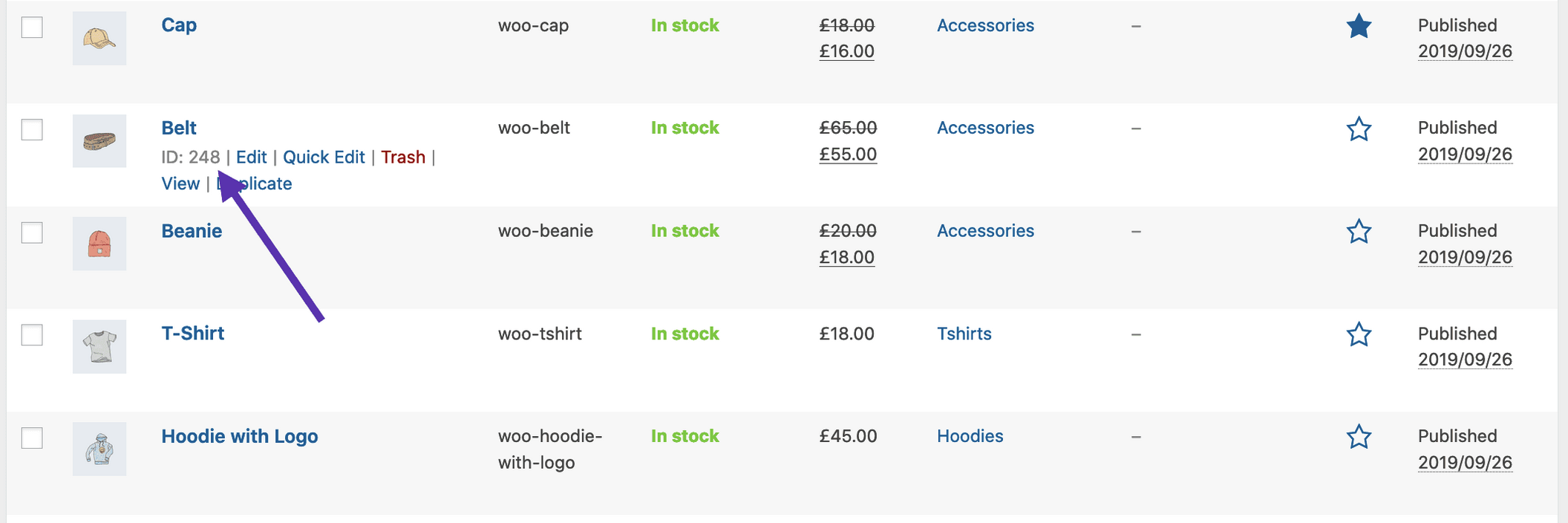
- best_selling – Will display your best selling products. Must be set to true.
- on_sale – Will display your on-sale products. Must be set to true.
Examples of Product Scenarios
[products limit="4" columns="4" orderby="popularity" class="quick-sale" on_sale="true" ]
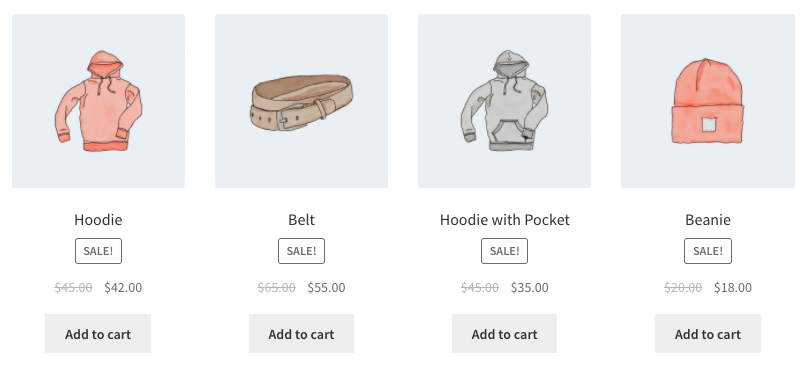
[products limit="4" columns="2" visibility="featured" ]

[products limit="3" columns="3" best_selling="true" ]
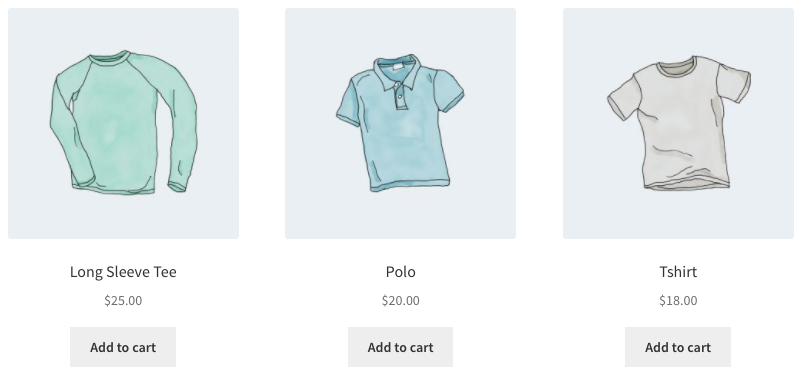
[products limit="4" columns="4" orderby="id" order="DESC" visibility="visible"]

[products limit="8" columns="4" category="hoodies, tshirts" cat_operator="AND"]
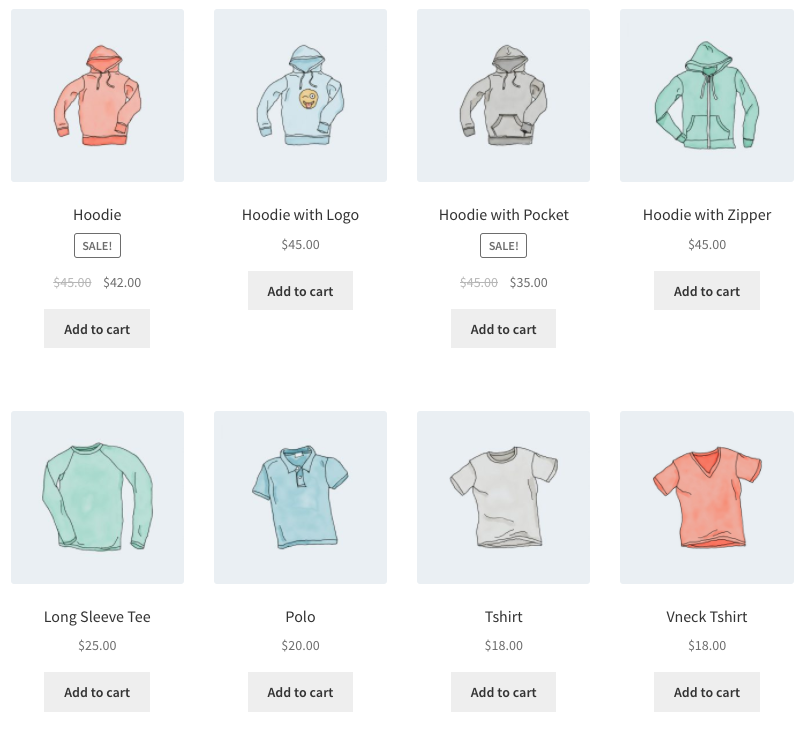
[products limit="8" columns="4" category="hoodies, tshirts" cat_operator="NOT IN"]
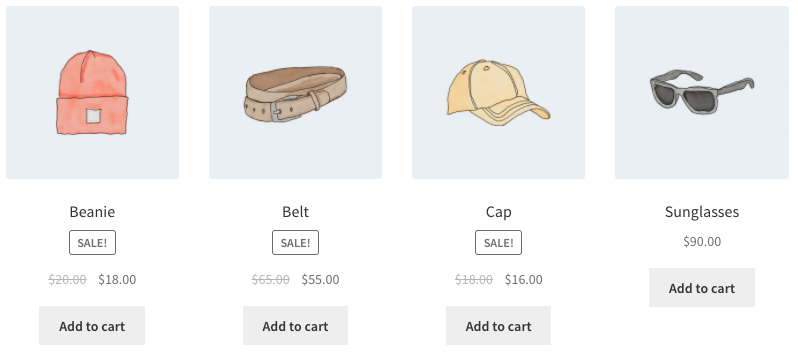
[products columns="3" attribute="season" terms="warm" orderby="date"]
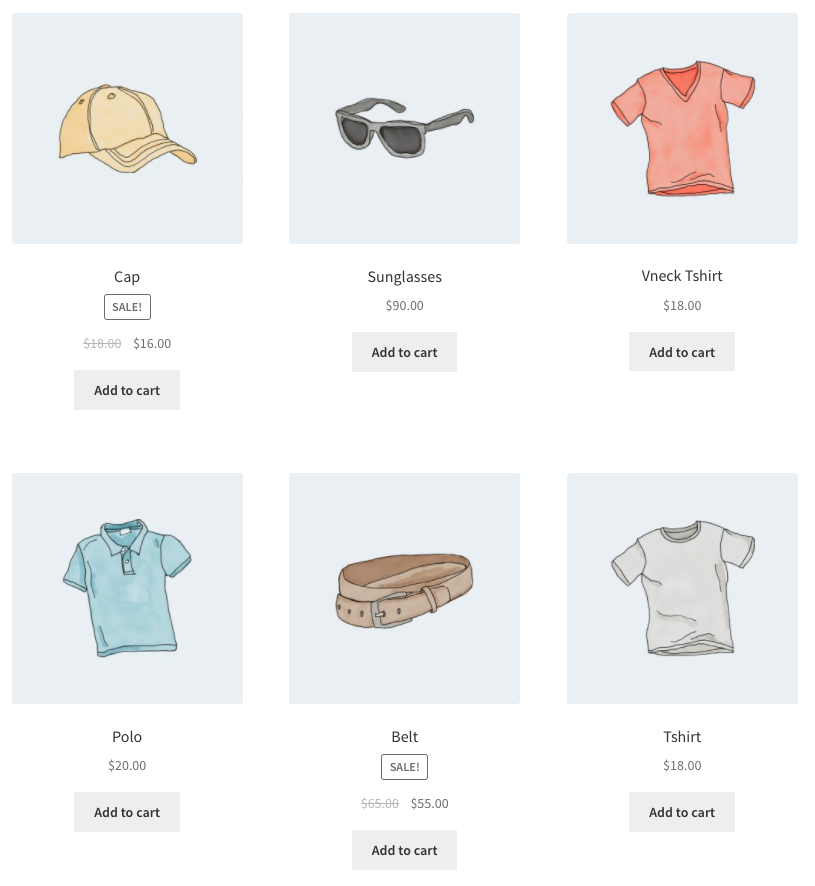
[products columns="3" attribute="season" terms="warm" terms_operator="NOT IN"]
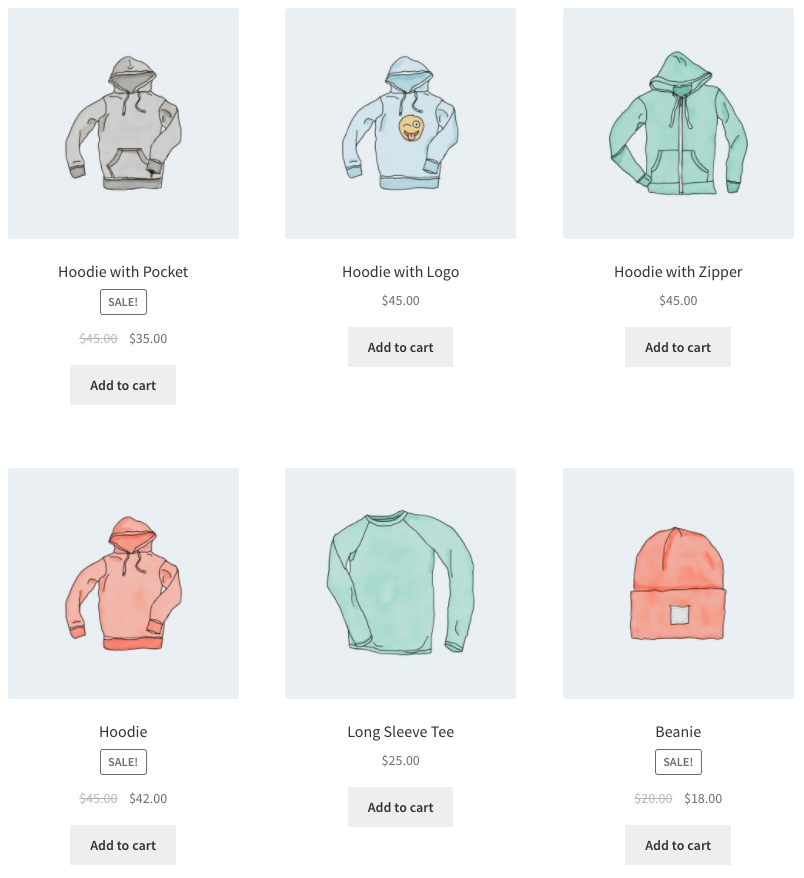

[products tag="hoodie"]
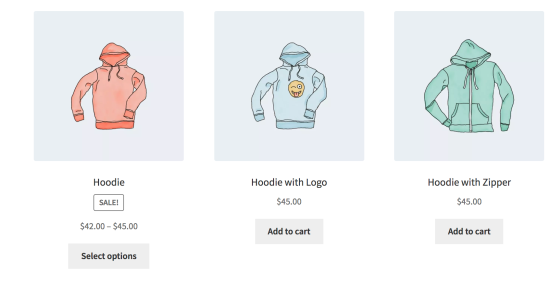
Sorting Products by Custom Meta Fields

add_filter( 'woocommerce_shortcode_products_query', 'woocommerce_shortcode_products_orderby' );
function woocommerce_shortcode_products_orderby( $args ) {
$standard_array = array('menu_order','title','date','rand','id');
if( isset( $args['orderby'] ) && !in_array( $args['orderby'], $standard_array ) ) {
$args['meta_key'] = $args['orderby'];
$args['orderby'] = 'meta_value_num';
}
return $args;
}Product Category
- [product_category] – Will display products in a specified product category.
- [product_categories] – Will display all your product categories.
Available Product Category attributes
- ids – Specify specific category ids to be listed. To be used in [product_categories]
- category – Can be either the category id, name, or slug. To be used in [product_category]
- limit – The number of categories to display
- columns – The number of columns to display. Defaults to 4
- hide_empty – The default is “1” which will hide empty categories. Set to “0” to show empty categories
- parent – Set to a specific category ID if you would like to display all the child categories. Alternatively, set to “0” (like in the example below) to show only the top-level categories.
- orderby – The default is to order by “name”, which can be set to “id”, “slug”, or “menu_order”. If you want to order by the ids you specified then you can use orderby="include"
- order – States whether the category order is ascending (ASC) or descending (DESC), using the method set in orderby. Defaults to ASC.
Examples of Product Category Scenarios
[product_categories number="0" parent="0"]
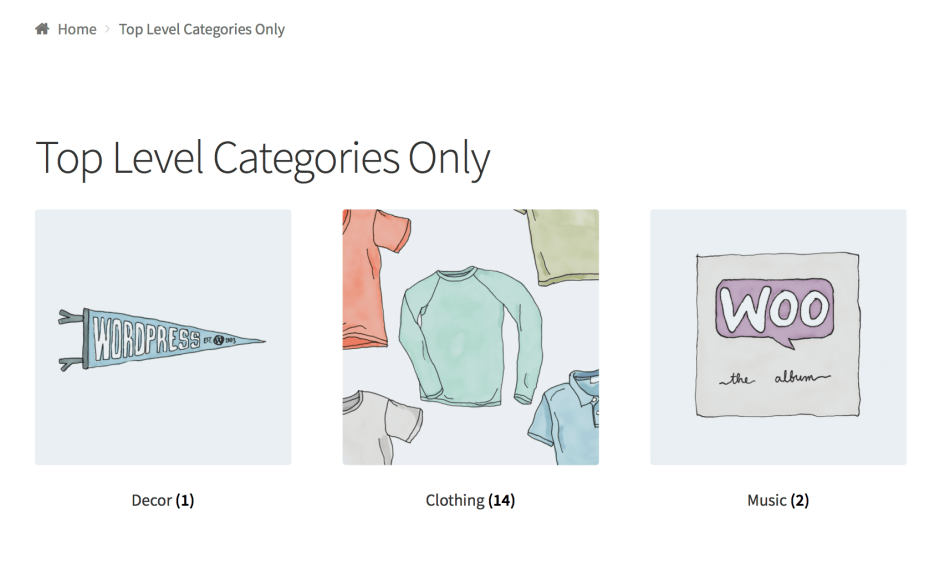
Product Page
[product_page id="99"]
[product_page sku=”FOO”]Related Products
array(
'limit' => '12',
'columns' => '4',
'orderby' => 'title'
)limit Argument

Add to Cart
array(
'id' => '99',
'style' => 'border:4px solid #ccc; padding: 12px;',
'sku' => 'FOO'
'show_price' => 'TRUE'
'class' => 'CSS-CLASS'
'quantity' => '1';
)[add_to_cart id="99"]
Add to Cart URL
array(
'id' => '99',
'sku' => 'FOO'
)[add_to_cart_url id="99"]
Display WooCommerce notifications on pages that are not WooCommerce
Troubleshooting Shortcodes

Variation Product SKU Not Shown
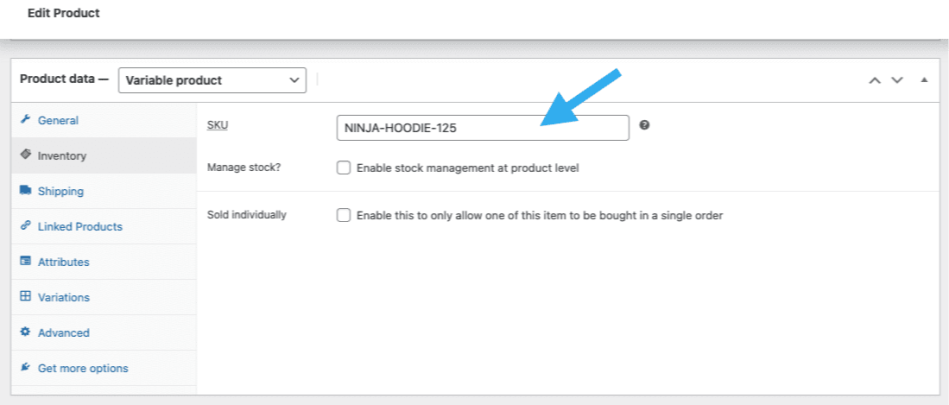
Related Articles
Groups WooCommerce - User Guide
Setup To sell memberships with WooCommerce requires the following extensions besides WooCommerce itself: Groups – Groups is free and designed as an efficient, powerful and flexible solution for group-oriented memberships and content access control. ...WooCommerce Analytics
WooCommerce Analytics is a new reporting and data analysis tool to help you manage your WooCommerce Store. The suite introduces nine new reports along with advanced filtering and segmenting tools, the ability to download all data to CSV, and a ...Basic Woocommerce - User Guide
For pricing and how to add to your website see at the bottom of the page. Adding and Managing Products Adding a product Before adding your first product, let’s get familiar with how product categories, tags, and attributes work. Product Categories ...Woocommerce Emails
Email Settings Options available to edit email settings and templates. Go to: WooCommerce > Settings > Emails. Email notifications For each WooCommerce email listed, it’s possible to configure your settings (optional). More detailed instructions ...Woocommerce Refunds
Summary In WooCommerce itself you can process refunds in two ways: Automatic: Refunds change the WooCommerce order status and also reverse the charge so your customer gets their money. Manual: Refunds change the WooCommerce order status, but you need ...